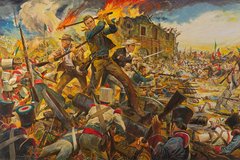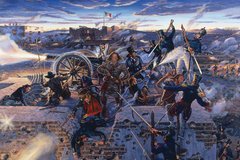The end of the Texas Revolution brought with it an increase in immigration from the United States to the newly formed Republic of Texas. Among these immigrants was Mary Ann (Adams) Maverick, the young wife of Samuel Maverick. Mary became the first known Anglo woman to settle permanently in San Antonio de Bexar. Later in life she wrote her memoirs detailing her trip west from South Carolina and life in San Antonio. Mary witnessed events such as the Council House Fight in 1840 and the “Runaway of ‘42.”
Born March 16, 1818 in Tuscaloosa County, Alabama to parents William Lewis Adams and Agatha Strother Lewis, Mary married Samuel Maverick of Pendleton, South Carolina on August 4, 1836 at the Adams family plantation home in Tuscaloosa, Alabama. Samuel Maverick had immigrated to Texas via Alabama in 1834. He settled in San Antonio in 1835 and when rebellion broke out he joined the Texan army, fighting in the Battle of Bexar under the command of Benjamin Milam. After the battle, he remained in San Antonio until March of 1836 when he was elected by the men of the Alamo to represent them at the convention in Washington-on-the-Brazos. In this capacity, he signed the Texas Declaration of Independence. Following the Battle of San Jacinto, Maverick returned to Alabama where he wed Mary Ann Adams.
On October 14, 1837, the young couple and their newborn son, accompanied by ten slaves and Mary’s younger brother Robert Adams, set off from the Maverick family plantation in South Carolina bound for Texas. The party crossed the Sabine River and entered into Texas on December 31, 1838. Their journey up this point had been without “serious trouble or accident” according to Mary. The thus-far uneventful trip took a turn for the worse as the group traveled through Texas. They experienced swamps, Northers, a lack of provisions and an encounter with a group of Tonkawa Indians. After an extended stay in Spring Hill, the Mavericks finally settled in San Antonio in June of 1838 joining Mary Maverick’s older brother William Adams, who had immigrated there in late 1836.
Mary Maverick’s memoirs are full of details about life in San Antonio during the 1830s and 1840s. She talks in great detail about her neighbors — Tejano and Anglo alike — and the entertainment and work that Texan women partook in. In one story Mary relates a trip to visit the headwaters of the San Antonio river with guests from Houston. She comments that even the ladies were “armed with pistols and bowie knifes,” an indication of the threat of Indian attack that was pervasive during this period of San Antonio’s history. In another passage Mary describes the summer of 1841 saying,
“During this summer, the American ladies led a lazy life of ease. We had plenty of books, including novels, we were all young, healthy and happy and were content with each others’ society. We fell into the fashion of the climate, dined at twelve, then followed a siesta, (nap) until three, when we took a cup of coffee and a bath.”
Life in San Antonio was not entirely carefree, however, as there were threats from both the Comanches and Mexicans in this frontier town.
Relations between Texas settlers and Indians dominate a good portion of Mary’s memoirs. The hostilities between the citizens of San Antonio and Comanches most notably resulted in the Council House Fight on March 19, 1840, an event which Mary witnessed. On this day approximately sixty-five Comanches entered into San Antonio seeking to make a peace treaty. They brought with them Matilda Lockhart who had been captured in December 1838 during a Comanche raid. The Comanche party included women and children as well as male warriors. Mary noted that, “The young Indians amused themselves shooting arrows at pieces of money put up by some of the Americans; and Mrs. Higginbotham and myself amused ourselves looking through the picket fence at them.”





